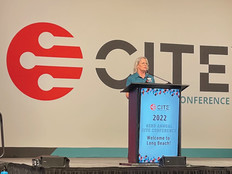One and Done
PolyVision's eno one mobile interactive whiteboard solution gives schools affordable, integrated, portable access to a 21st century learning environment.
PolyVision's winning three-in-one interactive whiteboard (combining dry-erase markers, magnets and multimedia in a single product) debuted in early 2009, but the company has been building writing surfaces for schools since 1954. That experience, plus a history of technological innovations and strategic partnerships, has served it well.
In the past year, PolyVision rolled out a budget-friendly integrated solution that gives teachers the flexibility and versatility they need to engage students in multisensory lessons. The eno one combines PolyVision's eno classic whiteboard, a short-throw projector, lesson development software and accessories in a single package. Better still, it comes in height-adjustable mobile, height-adjustable wall-mount and fixed wall-mount configurations, ensuring its adaptability to any classroom, teaching style or student need.
End-User Advantages
For this review, I tested the eno one height-adjustable mobile solution. The product's flexibility was apparent almost immediately: I could roll the assembled unit from one side of my classroom to the other by myself; and I could accommodate students of any height at the board by lifting up or pushing down on the handle.
Every eno product has a magnetic icon strip, which controls functionality via 20-plus commonly used tools. Most notable is the red pen, which can be used to activate helpful tools that don't appear on the strip. Plus, the strip can be moved to either side of the board.
PolyVision's partnerships with 3M and Hitachi ensure that images projected using eno one components are crisp and clear. Multimedia presentations are sharp and colors are vivid in any light, with virtually no glare.
The eno one's low cost of ownership also is appealing. Because the board can be mounted to existing surfaces, classroom demolition or remodeling is unnecessary.
Why It Works for IT
If there's a problem with the software or hardware, PolyVision can resolve most issues remotely. When I had trouble pairing my Bluetooth stylus with the eno, I called the customer service hotline, and within six minutes, I was teaching again.
PolyVision has adopted an open-architecture approach, which means educators can use any teaching tools they choose. But the company's partnerships with Qwizdom and RM Education ensure that every eno owner receives either Qwizdom's WizTeach or RM Easiteach Next Generation at no charge.
PolyVision works hard to ensure that a school's investment in eno is worthwhile, offering a "Forever Warranty" that's unconditional with normal usage. If a board's writing surface fails, the company will repair or replace it, no questions asked.
Disadvantages
I tested two styluses: the eno mini and the newer eno 2610A. When connected, they worked reasonably well. But sometimes there was a slight delay between the moment when I pressed the stylus to the board surface and when my handwriting appeared – a tendency known as screen lag. Occasionally, a stylus lost connectivity altogether and I had to reconnect.








